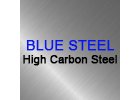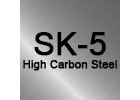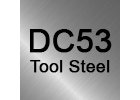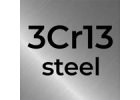classification by material
Hunting knives can be classified according to the material of their blades, which fundamentally affects their properties, durability, maintenance and suitability for specific tasks. Different materials offer different combinations of sharpness, durability and ease of sharpening, allowing users to choose the right knife for their needs.
#showmore#
Classification of hunting knives by blade material
1. Carbon steel
- Characteristics:
- It contains a high proportion of carbon (e.g. AISI 1095 or 1084), which ensures excellent sharpness and easy grinding.
- It is not resistant to corrosion and therefore requires regular care (lubrication and drying).
- Usage:
- Suitable for game processing and demanding cutting tasks.
- Popular with traditional hunting knives.
- Advantages:
- Holds a sharp edge longer than stainless steel.
- Easy focusing even in the field.
- Disadvantages:
- Susceptibility to corrosion.
- Requires more frequent maintenance.
2. Stainless steel
- Characteristics:
- Contains chromium (minimum 10.5%) for corrosion resistance (e.g. 440C, VG-10, Sandvik 14C28N).
- Modern stainless steels often offer a good balance between hardness and durability.
- Usage:
- Ideal for wet environments and knives requiring minimal maintenance.
- A great choice for outdoor activities where humidity is higher.
- Advantages:
- Corrosion resistance.
- Less maintenance.
- Disadvantages:
- Less easy to grind compared to carbon steel.
- Some steel types have poorer edge hold.
3. Damascus steel
- Characteristics:
- A combination of multiple steels layered together, creating a unique pattern on the blade.
- Highly aesthetic material with a good balance between hardness and flexibility.
- Usage:
- Suitable for collector's knives or knives intended for ceremonial use.
- Less common for intensive hunting tasks.
- Advantages:
- Attractive design and uniqueness.
- Good mechanical properties.
- Disadvantages:
- Higher price.
- Need regular maintenance (may be more susceptible to corrosion).
4. Tool steels
- Characteristics:
- High-strength and hard steels designed for extreme loads (e.g. D2, O1, A2).
- Combination of wear resistance and blade holding ability.
- Usage:
- Perfect for knives used for heavy cutting or processing of harder materials.
- Advantages:
- Excellent blade retention.
- High wear resistance.
- Disadvantages:
- Susceptibility to corrosion in some types (D2 has partial resistance).
- More difficult grinding.
5. Ceramic blades
- Characteristics:
- Made of ceramic materials such as zirconium.
- Extremely sharp and wear-resistant, but more fragile than metal blades.
- Usage:
- Used more for specific tasks (e.g. filleting).
- Advantages:
- Extreme sharpness.
- Corrosion resistance.
- Disadvantages:
- Brittleness - susceptibility to breakage when dropped or subjected to strong pressure.
- Difficult focus.
Choosing the right material
- For the traditional hunter: carbon steel offers excellent performance if regularly maintained.
- For outdoor enthusiasts: Stainless steel provides low maintenance and good corrosion resistance.
- For collectors: damascus steel offers aesthetics and exclusivity.
- For demanding tasks: Tool steels like D2 are the ideal choice.
Each material has its own specific advantages and limitations, so it is important to consider the purpose of the knife, the conditions of use and your own preferences.
-
 Damascus carbon steel
Damascus carbon steel
-
 Steel SKD11
Steel SKD11
-
 M390 Bohler Microclean
M390 Bohler Microclean
-
 Bohler N690 Stainless Steel
Bohler N690 Stainless Steel
-
 VG-10 Japanese steel
VG-10 Japanese steel
-
 Carbon steel 14,260
Carbon steel 14,260
-
 8Cr13MoV a 8CR14MoV
8Cr13MoV a 8CR14MoV
-
 D2 steel
D2 steel
-
 9Cr18MoV
9Cr18MoV
-
 Steel 10Cr15CoMoV
Steel 10Cr15CoMoV
-
 Steel Nitro-V
Steel Nitro-V
-
 steel CPM 20CV
steel CPM 20CV
-
 Steel CPM S35VN
Steel CPM S35VN
-
 Steel CPM S90V
Steel CPM S90V
-
 Blue Steel - Japanese steel
Blue Steel - Japanese steel
-
 damascus steel - Stainless
damascus steel - Stainless
-
 Steel Sandvik 14C28N
Steel Sandvik 14C28N
-
 6AL4V titanium alloy
6AL4V titanium alloy
-
 SK-5 Japanese steel
SK-5 Japanese steel
-
 Stainless steel AUS-8
Stainless steel AUS-8
-
 powder coated steel RWL-34
powder coated steel RWL-34
-
 Steel 154CM (440C)
Steel 154CM (440C)
-
 India Wootz steel
India Wootz steel
-
 DC53 steel
DC53 steel
-
 6Cr - 6Cr13 Steel
6Cr - 6Cr13 Steel
-
 3Cr13 Steel
3Cr13 Steel
Product sorting
List of products

The exclusive Mammoth Tusk Damasteel knife represents perfection from the hand of a master. The blade, made of powdered Damascus steel RWL34, combines strength and elegance. The...

Axe "Dellinger Valhalla" made of damascus steel & 352 hand-laid layers of 1095-15N20 (damascus steel) & including leather sheath & handle made of rosewood (Sisso Wood)

















































